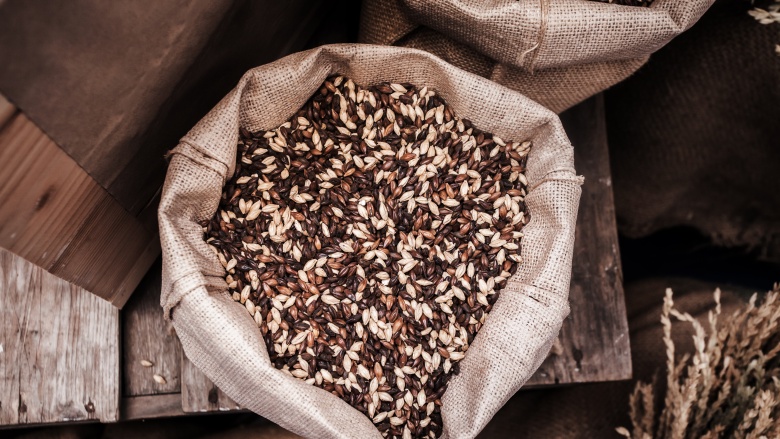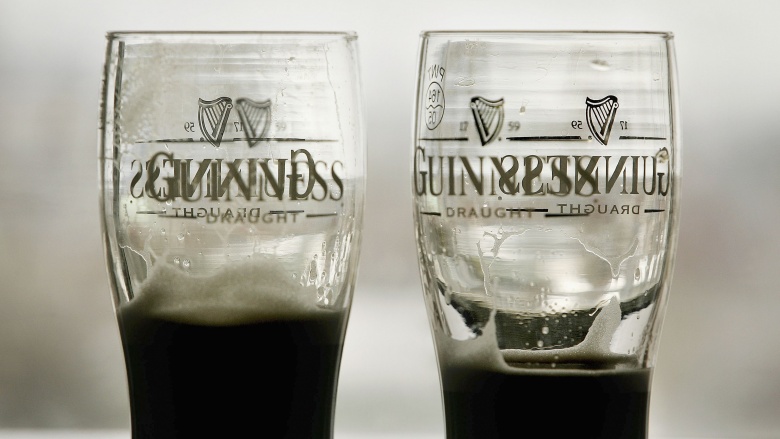The Real Reason Guinness Is Dark
In Ireland, there is a toast:
When money's tight and hard to get,
And your horse is also ran,
When all you have is a heap of debt,
A pint of plain is your only man.
Ireland's endurance of centuries of turmoil and hardship is epic, but one saving grace, at least since 1759, has been the quality of the legendary Irish stout brewed at the Guinness Brewery at St. James's Gate in Dublin. Beer trends have come and gone, but for the Irish, Guinness is a dána (bold and daring) brew that's a national symbol of pride. If you want a real taste of Éireann, forget about corned beef, colcannon, or soda bread. Do what Irishmen do, and order "a pint of plain" — Guinness draught. It has a cool index that's off the charts, even if your last name isn't O'Brien.
Guinness contains alcohol, so it isn't for carb- or calorie-counters. On the other hand, it's dynamite with a big, juicy, also-not-for-calorie-counters burger. A hop heavyweight, the bitterness is balanced by flavor notes of sweet malt and roasted coffee, and it's this balance that makes Guinness so attractive. Even in the face of stiff competition from light beers and newfangled American stouts, Guinness is still hanging in there. The other stouts can't compete with a low 4.2 percent ABV, and the brand's 200-year-old traditions and mystique don't hurt. Why else would more than 10 million glasses of "the dark stuff" be consumed every day in more than 100 countries around the globe? That many people can't be wrong!
But how many of them know the secret to the beer's pitch-black color? Care to find out yourself? Read on.
Porter or stout?
In a classic chicken-and-egg conundrum, it can be difficult to unravel whether porters or stouts came first. Beer historians and experts point out that in the 1700s and 1800s, porters were the "fathers" of stout, but over time, the two names have become almost interchangeable. Distinctions between the two are now blurred, and telling one from the other is difficult.
Historically, British and Irish stouts came in a range of sub-styles that followed conventional brewing practices and included American stouts, Imperial stouts, sweet stouts, English stouts, and Irish dry stouts like Guinness. Nowadays, though, you need a dance card to understand the style and ingredient variations by brand.
Crazy new recipes for barley malting and roasting abound, but Guinness' classic Irish dry stout follows traditional conventions and is as reliable as Penelope. For a typical profile, look for lower alcohol levels and a soft, creamy body, despite its thick, black appearance. A true Irish stout is always a perfumed blend of malted, roasted, and flaked barley that creates a harmonious base for the mashing, fermentation, and brewing that follows.
The secret's in the barley
Given the short ingredient list — malted barley, hops, yeast, and water — it should be easy to make delicious beer, right? Not that easy. The quality of the ingredients, mad attention to detail, and traditional Irish know-how all make Guinness distinct.
Without barley, there is no Guinness. This small, nutty-flavored cereal grain is the heart and soul of the brand and the foundation of the tastes and flavors that make Guinness special. The barley is sourced from local farmers, some of whom have been growing barley for the brewery for generations. From the moment the barley arrives at the brewery, the brewers handle it with the utmost care. Rather than outsource the malting process, Guinness takes the time to slowly malt the barley in small batches in their breweries. During malting, the barley is partially germinated in water and dried with hot air.
Once malted, the barley is carefully roasted to a rich black finish. Exactly 232 degrees Celsius is the sweet spot. There's more to the brewing process than just roasting barley, but it's the roast that does the trick. "Black at the edge, brown inside" brings out the flavors, aromas, and colors that make a beer a Guinness, a perfect example of Irish stout. But even though the barley is black when roasted, Guinness isn't exactly black when it gets to you.
Black is the new red
Reach for a two-toned glass of Guinness, and it's easy to fall prey to this traditional stout's trick of suspended animation. A perfectly poured glass of Guinness is as thick as molasses, and the contrast between dark and light is so distinct it looks painted onto the glass. The intense heat that cooks the natural sugars in the barley makes the grains black, yes, but according to Guinness, the finished stout isn't black at all, but a "dark ruby red" hue.
Don't believe us? See for yourself. Hold your glass up to the light. After that, enjoy the taste and stop worrying about the color.


